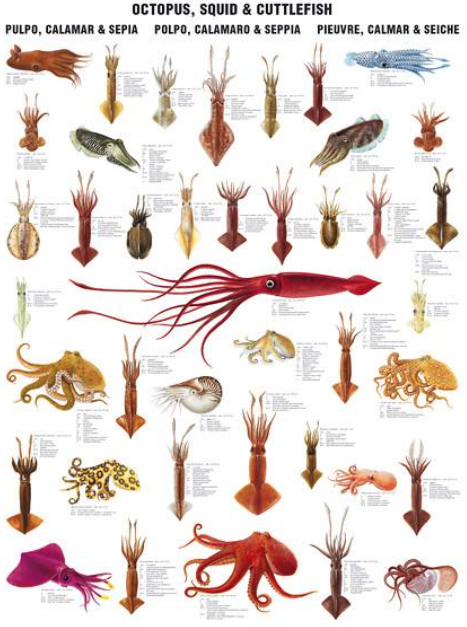
Shrimps And Cephalopods belong to a class of mollusks that appeared around 500 million years ago, includes :
• Octopus
• Squid
• Cuttlefish
• Nautilus
There now exists around 800 known species of cephalopods. However, scientists from around the world keep describing new species, especially from the abyss.
The two categories of cephalopods
Current classification divides cephalopods in two « sub-classes » :
1 Dibranchial cephalopods include three sub-orders
◦ Decapods (Sepioids : cuttlefish ; Teuthoids : squids ; Spiruloids : spirules),
◦ Octopods (octopus and relatives).
2 Tetrabranchial cephalopods are divided in two groups :
▪ Nautilus
▪ Ammonites (extinct group)
Dibranchial cephalopods
These have a bag-like body opening on the front, with variable shapes and sizes, and sometimes lateral fins.
They are excellent swimmers, and are characterized by having several hearts.
The main heart, also called “systemic”, is assisted by two small branchial hearts that pump oxygenated blood from the gills. Octopuses have a blue blood because their hemoglobin is replaced by hemocyanin.
The nervous system is highly concentrated. The arms are covered with suckers, attached by muscular fibers. Thanks to a system based on a hard ring around a soft muscle, suckers can create a vacuum in order to stick to nearly any kind of surface.
Dibranchial cephalopods all possess a beack with chitin jaws
The 3 orders :
1 Octopods have a rounded to elliptical body, and all have 8 arms. They have neither external nor internal shell. The eyes are quite small and are able to close thanks to eyelids. They can change color and aspect following their needs and will.
2 When they feel threatened, they can eject a dark ink in order to blind out the predator while they escape.
3 Octopuses (called zoorit in many places of the Indian ocean, but also pwedzain Shimaoré) are very clever animals.
4 But they are also often present in traditional diet, and experience a strong fishing pressure.
5 There are species of octopods in all of the world’s seas, from abyssal plains to shallow
lagoons such as Mayotte.
6 Decapods have an elongated body : they are the squids and cuttlefishes. They have foud pairs of sessile arms and a pair of elongated tentacular arms, ending with a flat club.
7 Contrary to octopods, they have a pair of latero-dorsal or lateral fins.
8 However, just like octopods, one or two of the sessile arms are modified for reproduction
9 They have an internal “shell”, hidden in the body cavity, cuttlefish have a floating board (“bone”) and squids a sort of hard “feather”.
10 Vampyromorphs. Currently consist in only one species, living in the abyss ; being part of the “octopodiforms”, some specialist rank them among octopods
Tetrabranchial cephalopods
There are numerous fossile species in this group, but only a small group remains alive nowadays : nautilus.
Tetrabranchial cephalopods re distinguished by the hard shell covering their body.
Instead of arms, they have numerous retractable tentacles surrounding the animal’s head.
The eyes are pedunculated, without crystalline.
There are four gills and no branchial hearts.
Species in this group are mostly pelagical and can be found mostly in the Pacific ocean.
Cephalopods and the sea
All cephalopods are strictly marine animals, with no known exception.
Some live close to the shore, and others live very far from it. Many species can be found in warm waters, however several species are adapted to polar seas.
Cephalopods can propel themselves thanks to a siphon from where they eject water, allowing them to flee quickly from a threat.
They can also expel a cloud of ink while escaping, which is produced by an special gland..
If an arm gets cut, it can regrow.
Giant cephalopods: myth or reality ?
The existence of giant cephalopods living in the deep sea eventually got confirmed.
Evidence includes large biting scars left on their main predator: sperm whales.
Some specimens reaching nearly 20m long have also been found or fished (Teuthoid squids such as Architeutis, Mesonychoteuthis and Histiotheuthis).
